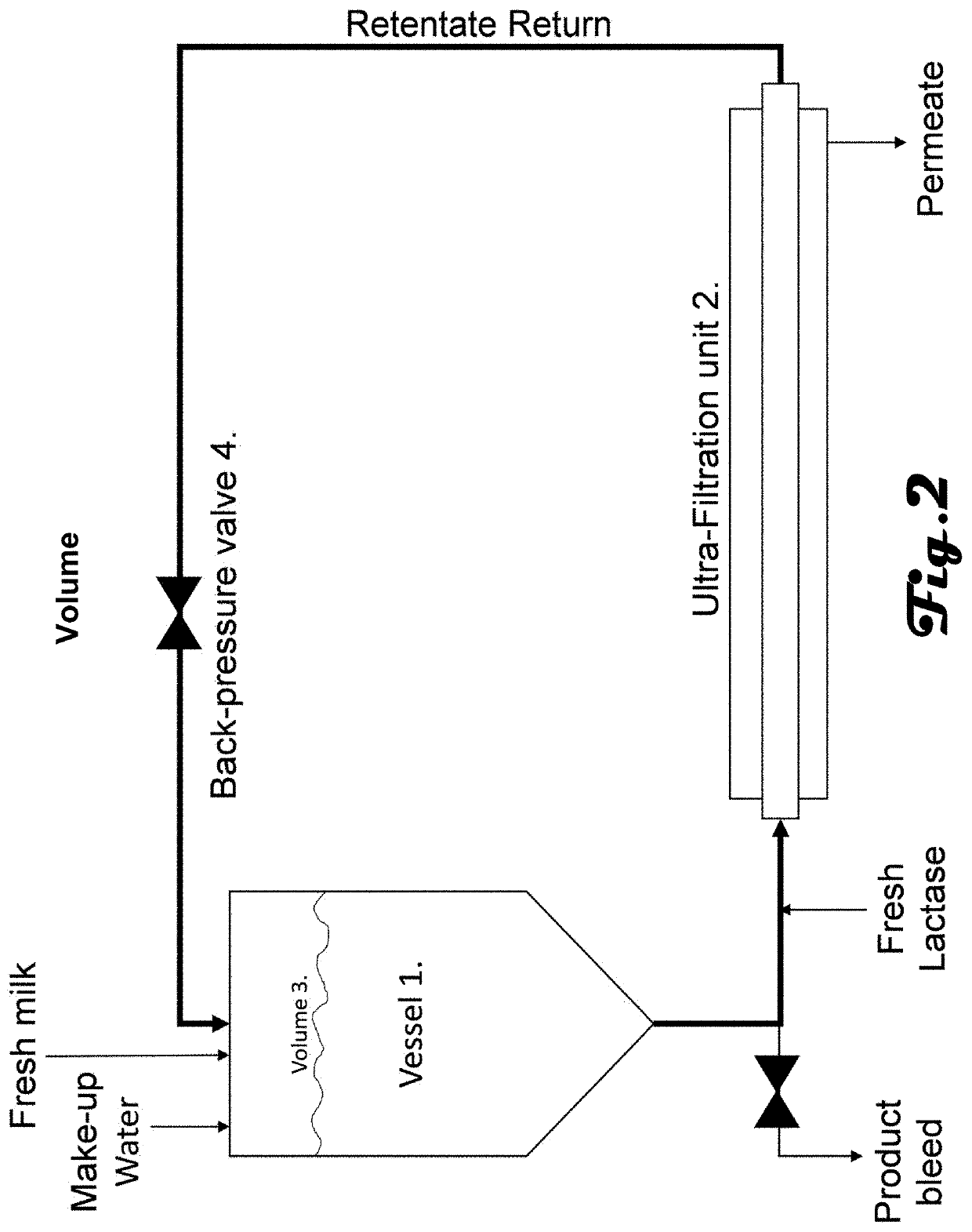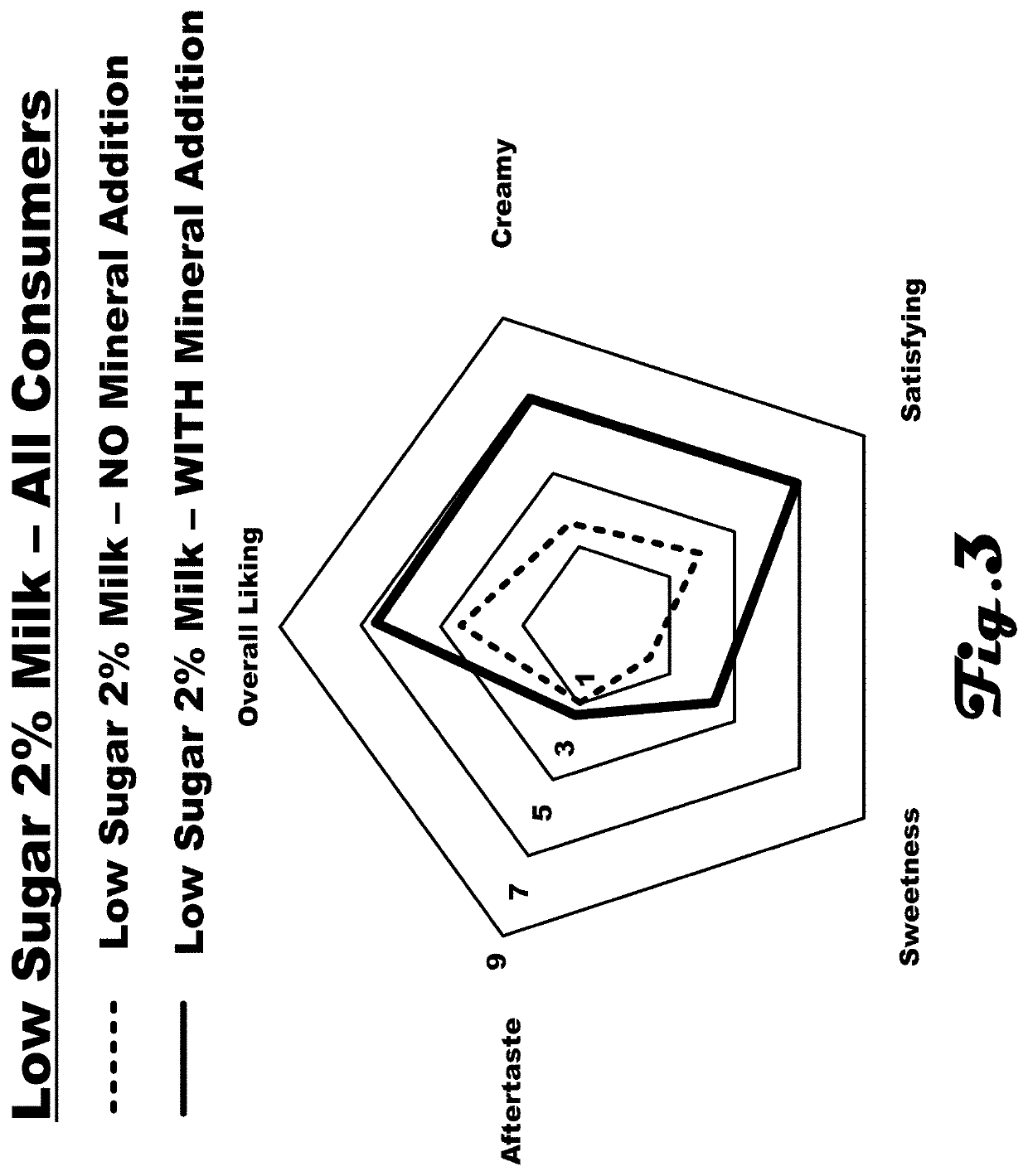Process for making a dairy beverage with improved nutrition
a technology of dairy products and processing methods, applied in the field of dairy products, can solve the problems of raw milk tanks having to be separated, silos taken out of the normal production cycle, and lactose deficiency, etc., and achieve the effect of high pressure processing
- Summary
- Abstract
- Description
- Claims
- Application Information
AI Technical Summary
Benefits of technology
Problems solved by technology
Method used
Image
Examples
example 1
Exemplary Implementation—Embodiment 1
[0104]2% milk was processed with diafiltration so that the volume of the retentate remained the same. Lactose was steadily removed through the permeate until it reached a concentration of 0.1% w / w in the retentate stream. The concentration of protein and fat remained essentially the same in the final retentate as in the original 2% milk starting material. The concentrations of unbound minerals in the retentate were also reduced through losses in the permeate stream in line with the lactose. Calcium ions which are bound in milk were only slightly reduced in this example. The resulting no-sugar (low-sugar) retentate product was heat treated to pasteurize the product and extend shelf life. In the next step, potassium chloride and sodium chloride were added to the resulting no-sugar (low-sugar) retentate product. The potassium chloride was added to a concentration of 0.115% w / w, and the sodium chloride was added to a concentration of 0.091% w / w to fo...
example 2
Exemplary Implementation—Embodiment 2
[0107]2% milk was processed with diafiltration so that the volume of the retentate remained the same. Lactose was steadily removed through the permeate until it reached a concentration of 0.16% w / w in the retentate stream. The concentration of protein (3% w / w) and fat (1.8% w / w) remained essentially the same in the final retentate as in the original 2% milk starting material. The concentrations of unbound minerals in the retentate were also reduced through losses in the permeate stream in line with the lactose. Calcium ions which are bound in milk were reduced from 79 mg / 100 g to 64 mg / 100 g in this example. One portion of the resulting no-sugar (low-sugar) retentate product was heat treated (100 C for 6 secs) to pasteurize the product and extend shelf life, i.e. providing a low-sugar 2% milk without mineral addition. A second portion of the resulting no-sugar (low-sugar) retentate product had a mineral mix of potassium chloride, sodium chloride,...
example 3
Exemplary Implementation—Embodiment 3
[0110]Skimmed milk was processed with diafiltration. In this case, the resulting retentate was concentrated to approximately twice the protein content (6.8%) of the incoming milk. Lactose was steadily removed through the permeate until it reached a concentration of around 0.1% w / w in the retentate stream. Cream (at 45% fat) was then added to the retentate to achieve a final fat content of 3.4% The resulting low-sugar UF concentrate had the composition shown in the table below. The low-sugar UF concentrate was then transferred to a batching system where water and a mineral mix of sodium chloride, potassium chloride, dipotassium phosphate, tricalcium phosphate, and high acyl gellan gum were added to achieve the composition concentration in the table (low-sugar UF finished product) and according to the recipe shown in Table 4 below.
TABLE 4Recipe for production of a sugar-free reduced fat milk product froma low sugar UF concentrate.Ingredient% Additi...
PUM
 Login to View More
Login to View More Abstract
Description
Claims
Application Information
 Login to View More
Login to View More - R&D
- Intellectual Property
- Life Sciences
- Materials
- Tech Scout
- Unparalleled Data Quality
- Higher Quality Content
- 60% Fewer Hallucinations
Browse by: Latest US Patents, China's latest patents, Technical Efficacy Thesaurus, Application Domain, Technology Topic, Popular Technical Reports.
© 2025 PatSnap. All rights reserved.Legal|Privacy policy|Modern Slavery Act Transparency Statement|Sitemap|About US| Contact US: help@patsnap.com



